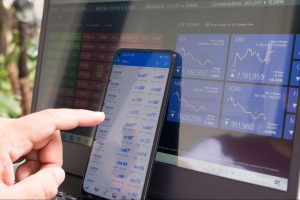Candlestick charts and patterns are a very helpful tool for studying the psychological tendencies of traders as well as the underlying currents in price movement. There is significance in each component of a candlestick, including the hue of the body, the span of the wick or tail, and the overall size of the candlestick itself.
Studying a candlestick can be done singly or in conjunction with other candlesticks, based on a variety of elements such as the momentum that occurred before the formation of the candlestick pattern, which also plays a role in the success of the pattern.

Within the context of the financial markets, the inside bar pattern may be seen rather frequently. The trader’s ability to do effective market research can be improved by including the inside bar approach inside their trading system. The inside day candlestick is a type of price bar that creates a range between the previous day’s high and low prices. This range is called an “inside day range.” It is a pattern consisting of two bars that may be utilized in a wide range of different trading techniques
Forex traders see the inside day candle pattern as a sign that the market is about to break out of its consolidation phase and go upward. Because of its versatility, it is well-suited for the execution of a wide variety of intraday, swing, and inside-day trading methods.
How To Recognize It?
One of the most appealing characteristics of the inside day candlestick patterns is the fact that they are simple to apply. It is simple to recognize and make use of the structure, and it does not matter how much expertise you have.
All that is required of you to spot the inside day candle pattern is a daily chart that uses Japanese candlesticks. For a candle to be considered suitable for use inside, it must possess the following qualities:
- The highest point reached by the candlestick is lower than the highest point reached the day before;
- The low point of the candlestick is higher than the low point of the previous trading day.
The candle representing the current day is completely obscured by the candle representing the day before it. Because of this, it is classified as an inside pattern because the trading range is rather narrow.
Bullish Candlestick Patterns
Active traders who depend on technical analysis have access to a wealth of information on inside trading days. When all of the following conditions are met, an inside day candle is seen as having bullish potential:
- The price of the candle after it is blown out is higher than its opening price.
- The inside day takes place within an upward price trend.
If a Forex trader believes the market to be bullish, there is a good chance they will use a buy or long inside day trading strategy.
Bearish Candlestick Patterns
Bearish inside days, on the other hand, are indicative of impending sell-side pressure, in contrast to bullish inside days. When all of the following criteria are met, an inside day can be seen as negative for the market:
- The price of the candle when it is blown out is lower than when it was first sold.
- The downturn has been rather noticeable throughout the entire day.
In most cases, a bearish inside day will take place within the context of a larger bad market. As a result, sell-side plans can be put into action.
Traders that are actively involved in the market see the inside day pattern as a sign of consolidation. From the perspective of day trading strategy, this is perfect for range trading techniques and breakout trading strategies.
Inside Bar Breakout Technique
The inside bar denotes a brief period of low volatility consolidation inside a moving market. After a new high/low is made, traders next try to trade breakouts.
The breakthrough takes place below the low of the “preceding bar,” leading to a market short entry. Indicating a probable trend reversal, a breakout above the high of the “preceding bar” might signify a long (buy) entry. Since trading against the trend is riskier, traders are more cautious while doing so.
The preceding swing high or low might serve as a stop level (depending on trend) as determined by important price action levels. To realize the take profit (limit) level, traders might utilize the stop distance as a benchmark and enlarge it by a factor of two. This results in a risk-reward ratio of 1:2, which is consistent with prudent risk management. Fibonacci extensions can also be used to forecast limits.
Final Thoughts
This trading pattern is more complicated since within bars indicate either continuation or reversals. Since false breakouts might happen, employing the inside bar as a standalone pattern is less reliable, which is why traders prefer incorporating it into their entire forex trading plan. In other words, the approach serves as the cornerstone, while the inside bar serves more as a prompt.






Leave a Reply